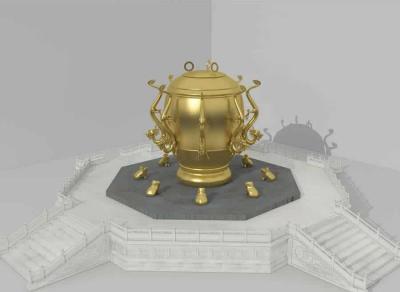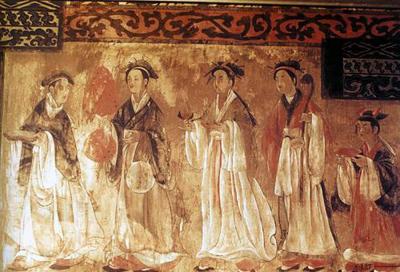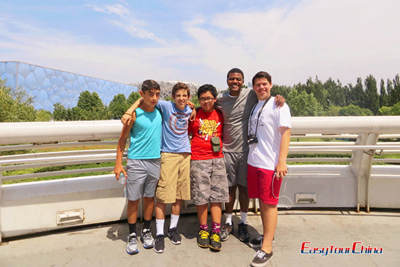Han Dynasty
The Han Dynasty, the second imperial dynasty of China, ruled China from 202 BC to 220 AD. It succeeded the short-lived Qin Dynasty (221-206 BC) and was followed by the Three Kingdoms (220-280 AD). From the time when Liu Bang declared himself “emperor” and established the Han Dynasty until Emperor Xian was deposed by Cao Pi, the Han emperors ruled China for 407 years.
The dynasty was divided into Western Han (also known as Former Han, 202 BC - 9 AD) and Eastern Han (also Later Han, 25-220 AD), interrupted by the rebellious Xin Dynasty established by Wang Mang. The Western Han was a period of consolidation and made some military extensions. The Eastern Han gradually saw the abdication of the last Han emperor and the beginning of some 400 years of turmoil.
The Han Dynasty was the first dynasty to embrace the philosophy of Confucianism. Under the Han Dynasty, China made great advances in many areas of the arts and sciences. During this period, agriculture, handicrafts and commerce flourished, and the population reached 50 million. The Han Dynasty is one of the longest lasting dynasty, a golden age, and one of the greatest dynasties in the history of China.
Han Dynasty Facts
Han Dynasty Emperors & Timeline with Years
Below is China’s Han Dynasty timeline with a chronological list of emperors of the Han Dynasty. During the long-lived Han Dynasty, there were 28 emperors in total, including those who were deposed. The first emperor of the Han Dynasty was Liu Bang, Emperor Gaozu of Han. The last emperor of the Han Dynasty was Liu Xie, Emperor Xian of Han. The most important emperors of the Han Dynasty are Emperor Gaozu, Emperor Wen, Emperor Jing, and Emperor Wu.
| Sovereign | Personal Name | Posthumous Name | Reign Years | Mausoleum | Remarks |
|---|---|---|---|---|---|
| Western Han Dynasty (202 BC - 9 AD) | |||||
| Emperor Gaozu of Han (汉高帝) | Liu Bang (刘邦) | Emperor Gao (高皇帝) | 202-195 BC | Changling Mausoleum (长陵) | The founder and first emperor of the Han Dynasty |
| Emperor Hui of Han (汉惠帝) | Liu Ying (刘盈) | Emperor Xiaohui (孝惠皇帝) | 195-188 BC | Anling Mausoleum (安陵) | |
| Emperor Qianshao of Han (前少帝) | Liu Gong (刘恭) | N/A | 188-184 BC | Unknown | |
| Emperor Houshao of Han (后少帝) | Liu Hong (刘弘) | N/A | 184-180 BC | Unknown | |
| Emperor Wen of Han (汉文帝) | Liu Heng (刘恒) | Emperor Xiaowen (孝文皇帝) | 180-157 BC | Baling Mausoleum (霸陵) | Started “Wen Jing Zhi Zhi” (文景之治), the first prosperous age in ancient China |
| Emperor Jing of Han (汉景帝) | Liu Qi (刘启) | Emperor Xiaojing (孝景皇帝) | 157-141 BC | Yangling Mausoleum (阳陵) | Continued and improved the governance of Emperor Wen |
| Emperor Wu of Han (汉武帝) | Liu Che (刘彻) | Emperor Xiaowu (孝武皇帝) | 141-87 BC | Maoling Mausoleum (茂陵) | The greatest Han emperor, and one of the greatest emperor in Chinese history |
| Emperor Zhao of Han (汉昭帝) | Liu Fuling (刘弗陵) | Emperor Xiaozhao (孝昭皇帝) | 87-74 BC | Pingling Mausoleum (平陵) | Started “Zhao-Xuan Resurgence” (昭宣中兴), a period of stability and economic growth |
| Marquis of Haihun (汉废帝) | Liu He (刘贺) | N/A | 74 BC | Unknown | Deposed |
| Emperor Xuan of Han (汉宣帝) | Liu Xun (刘询) | Emperor Xiaoxuan (孝宣皇帝) | 74-49 BC | Duling Mausoleum (杜陵) | During his reign, the Han Dynasty reached its peak. |
| Emperor Yuan of Han (汉元帝) | Liu Shi (刘奭) | Emperor Xiaoyuan (孝元皇帝) | 49-33 BC | Weiling Mausoleum (渭陵) | The Western Han Dynasty went into decline. |
| Emperor Cheng of Han (汉成帝) | Liu Ao (刘骜) | Emperor Xiaocheng (孝成皇帝) | 33-7 BC | Yanling Mausoleum (延陵) | The Western Han Dynasty continued disintegration. |
| Emperor Ai of Han (汉哀帝) | Liu Xin (刘欣) | Emperor Xiao’ai (孝哀皇帝) | 7-1 BC | Yiling Mausoleum (义陵) | |
| Emperor Ping of Han (汉平帝) | Liu Kan (刘衎) | Emperor Xiaoping (孝平皇帝) | 1 BC - 6 AD | Kangling Mausoleum (康陵) | |
| Ruzi Ying (孺子婴) | Liu Ying (刘婴) | N/A | 6-9 AD | Unknown | The last ruler of the Western Han Dynasty and a puppet ruler controlled by Wang Mang. He didn’t officially ascend to the throne. |
| Eastern Han Dynasty (25-220 AD) | |||||
| Emperor Guangwu of Han (汉光武帝) | Liu Xiu (刘秀) | Emperor Guangwu (光武皇帝) | 25-57 AD | Yuanling Mausoleum (原陵) | The first emperor of Eastern Han Dynasty |
| Emperor Ming of Han (汉明帝) | Liu Zhuang (刘庄) | Emperor Xiaoming (孝明皇帝) | 57-75 AD | Xianjie Mausoleum (显节陵) | He ordered the construction of China’s first Buddhist temple White Horse Temple. |
| Emperor Zhang of Han (汉章帝) | Liu Da (刘炟) | Emperor Xiaozhang (孝章皇帝) | 75-88 AD | Jingling Mausoleum (敬陵) | Famous for his cursive script |
| Emperor He of Han (汉和帝) | Liu Zhao (刘肇) | Emperor Xiaohe (孝和皇帝) | 88-106 AD | Shenling Mausoleum (慎陵) | The Han Dynasty reached its peak during his reign |
| Emperor Shang of Han (汉殇帝) | Liu Long (刘隆) | Emperor Xiaoshang (孝殇皇帝) | 106 AD | Kangling Mausoleum (康陵) | The youngest and shortest-lived emperor in Chinese history |
| Emperor An of Han (汉安帝) | Liu Hu (刘祜) | Emperor Xiao’an (孝安皇帝) | 106-125 AD | Gongling Mausoleum (恭陵) | |
| Marquess of Beixiang (汉少帝) | Liu Yi (刘懿) | N/A | 125 AD | Unknown | |
| Emperor Shun of Han (汉顺帝) | Liu Bao (刘保) | Emperor Xiaoshun (孝顺皇帝) | 125-144 AD | Xianling Mausoleum (宪陵) | Eunuchs and consort kin were in control of state affairs. |
| Emperor Chong of Han (汉冲帝) | Liu Bing (刘炳) | Emperor Xiaochong (孝冲皇帝) | 144-145 AD | Huailing Mausoleum (怀陵) | |
| Emperor Zhi of Han (汉质帝) | Liu Zuan (刘缵) | Emperor Xiaozhi (孝质皇帝) | 145-146 AD | Jingling Mausoleum (静陵) | |
| Emperor Huan of Han (汉桓帝) | Liu Zhi (刘志) | Emperor Xiaohuan (孝桓皇帝) | 146-168 AD | Xuanling Mausoleum (宣陵) | Eunuchs dominated the central government. |
| Emperor Ling of Han (汉灵帝) | Liu Hong (刘宏) | Emperor Xiaoling (孝灵皇帝) | 168-189 AD | Wenling Mausoleum (文陵) | |
| Liu Bian | Liu Bian (刘辩) | N/A | 189 AD | The only deposed emperor of the Eastern Han Dynasty, and the only emperor was buried in the tomb of a eunuch in Chinese history | |
| Emperor Xian of Han (汉献帝) | Liu Xie (刘协) | Emperor Xiaoxian (孝献皇帝) | 189-220 AD | Shanling Mausoleum (禅陵) | The last emperor of the Eastern Han Dynasty |
Emperor Wu
Emperor Wu of Han (汉武帝, 156-87 BC), the seventh emperor of the Han Dynasty, ruled ancient China from 141 to 87 BC. He reigned for 54 years, making him the longest-reigning emperor of the Han Dynasty. Emperor Wu is regarded as the greatest Han emperor, and one of the greatest emperors in Chinese history due to his leadership and achievements.
Fall of the Han Dynasty
During the late period of the Eastern Han Dynasty, palace eunuchs and consort kin took turns controlling the central government, destabilizing imperial policy. The nobility monopolized regional offices and resources. The last few years leading up to its demise were filled with great chaos and war as one branch of government toppled another, leaving the region vulnerable to barbarian invasion.
The Yellow Turban Rebellion (黄巾起义) headed by Zhang Jiao broke out in 184 AD. Although it was finally put out, the Eastern Han Dynasty had already existed in name only. The Han Dynasty formally ended in 220 AD when Cao Pi, the son of Cao Cao, forced Emperor Xian from his throne. And China broke up into three kingdoms which is known as the Three Kingdoms period.
Han Dynasty Achievements & Inventions
Invention of Paper
The oldest extant ancient paper fragment was part of a map unearthed at the Fangmatan archaeological site of Gansu Province in 1986, which can be dated to 179-141 BC of the Western Han Dynasty. However, Cai Lun (蔡伦), an imperial eunuch official of the Eastern Han Dynasty, is traditionally attributed to the invention of the first high-quality writing paper.
This improved paper making is listed as one of the "Four Great Inventions" of ancient China. Chinese paper-making techniques spread to Central Asia and the world through the Silk Road. Paper is considered one of the greatest inventions of human beings. Cai Lun is ranked the seventh in Michael H. Hart’s book The 100: A Ranking of the Most Influential Persons in History.
Invention of Seismograph

The first seismograph to detect distant earthquakes was created in 132 AD by Zhang Heng (张衡), an astronomer, mathematician, inventor, geographer, and litterateur during the Eastern Han Dynasty. The seismograph was called Houfeng Didong Yi (候风地动仪), which literally means an instrument for measuring the seasonal winds and the movements of the Earth.
Invention of Mafeisan
The oldest anesthetics in the world was Mafeisan (麻沸散). It’s an oral herbal general anesthetic invented by Hua Tuo (华佗), an outstanding traditional Chinese medicine physician and also a surgeon in the late Eastern Han Dynasty. According to the Book of the Later Han (《后汉书》), Hua Tuo would give patients to drink Mafeisan dissolved in a wine before surgery. Unfortunately, the original prescription has been lost.
Invention of Sternpost Rudder
According to archaeological discoveries, China is the first country in the world to invent the stern rudder. A copper pot was unearthed from the Mausoleum of the Nanyue King in Guangzhou in 1983. It’s painted with four large ships with rudders. The copper pot can be dated back to the early Western Han Dynasty. The rudder enabled boats to steer without poles or oars. The earliest recorded use of the rudder in the West was in 1180.
Han Dynasty Clothing
In recent years, it’s common in China to see young girls wearing "Hanfu" (汉服, literally Han clothing) in various tourist attractions, parks, and pedestrian streets in the city. Strictly speaking, the resurgent Hanfu is not equal to the Han Dynasty clothing.
Hanfu refers to the traditional clothing of the Han Chinese people from over 3,000 years ago to the 17th century before the Qing Dynasty, including different costume styles of Chinese dynasties. And it experienced a notable change through time. The actual ancient Han Dynasty clothing style was more minimal in appearance.
Han Dynasty clothing mostly followed the clothing system of the Qin Dynasty, with only a handful of styles. During the Qin Dynasty, black was considered a superior color, preferred by noble people. The “dark style” has been carried out in the Western Han period. In the Eastern Han period, red became the most respectful color. The costumes of the Han Dynasty didn’t have complete regulation until the reign of Emperor Ming of the Eastern Han Dynasty.
A strict hierarchical system was set up in the Western Zhou Dynasty. Since then, clothes were used as a method of distinction between the nobility and common people. People from different social statuses wore clothes and accessories made of different materials. Wealthy families wore fine clothes, while poor people wore clothes made of linen.
Han Dynasty clothes mainly included pao (袍, robe), chanyu (襜褕, straight single-layer garment), ru (襦, short jacket), and qun (裙, skirt). The main styles were shangyi xiachang (上衣下裳, garment and long skirt), shenyi (深衣, long robe), and ruqun (襦裙, short jacket and skirt). Shenyi was cut separately as a tunic and long skirt, but sewn into one piece. It could be worn by both males and females in the Han Dynasty. Ruqun was popular clothes for women in the Han Dynasty.



